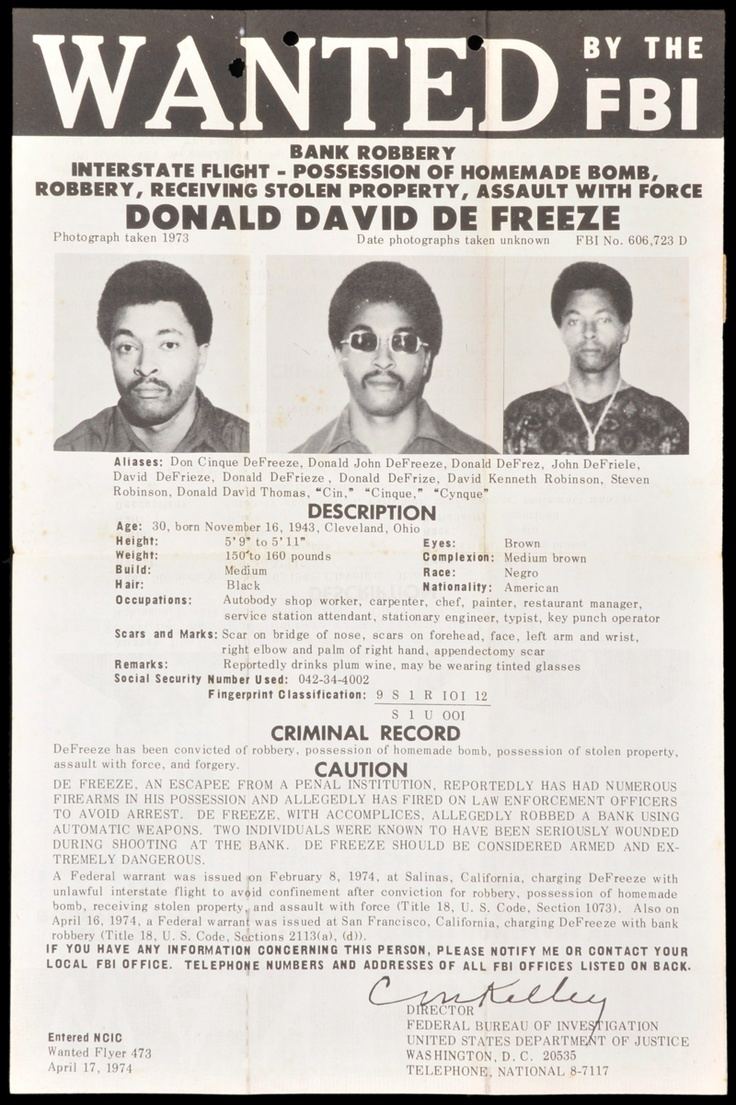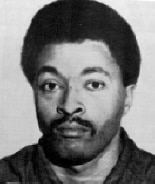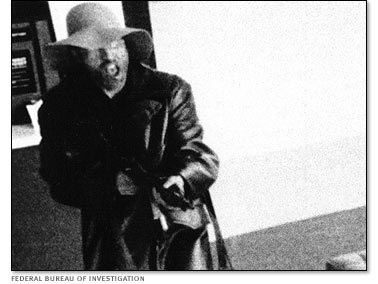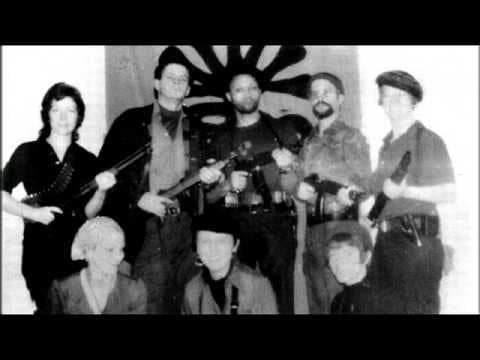Name Donald DeFreeze | ||
 | ||
Other names Field Marshal Cinque, Cinque Mtume Organizations founded | ||
Judge joe brown patty hearst kidnapper donald defreeze of sla met with ca attorney general
Donald David DeFreeze (November 15, 1943 – May 17, 1974), also known as Cinque Mtume, was the leader of the American far-left militia group Symbionese Liberation Army, a group operating in the mid-1970s, under the nom de guerre "Field Marshal Cinque".
Contents
- Judge joe brown patty hearst kidnapper donald defreeze of sla met with ca attorney general
- Early life
- Prior arrests warnings and probations
- Imprisonment and the Black Cultural Association
- Escape
- SLA
- Evidence of police informing
- DeFreezes arrest records
- Work of DeFreezes prison tutor with police units
- Links of CIA to police departments
- Death
- References

Early life

DeFreeze was born in Cleveland, Ohio, to African-American parents Louis and Mary DeFreeze, the eldest of eight children. His mother was a registered nurse at a convalescent home. His father was a violent man who punished him three times as a child by breaking both his arms. He dropped out of school in the ninth grade at age 14 and ran away from home. He moved to Buffalo, New York, where he lived with the Rev. William L. Foster, a fundamentalist minister, and his family. He became a street gang member in Buffalo. The Rev. Foster would say of him later:


He was arrested for stealing from parking meters and stealing a car. He was sent to the state reformatory in Elmira, New York. In 1970, DeFreeze wrote of his time here, which he called a prison or a mental institution:


DeFreeze moved to the Newark area. In 1963, he married Gloria Thomas, who had three children from a previous marriage. DeFreeze and Thomas had three children together. In 1964 his wife had him arrested for desertion. In 1965 DeFreeze moved with his family to California, where they settled in Los Angeles. He said that the worries of trying to support the children engulfed him. He wrote, "I just couldn't take it anymore. I was slowly becoming a nothing".
Prior arrests, warnings and probations
In 1964, police stopped DeFreeze while he was hitchhiking on the San Bernardino Freeway near West Covina, California, and found a tear-gas pencil bomb, a sharpened butter knife, and a sawed-off rifle in his suitcase.
In 1965, DeFreeze was arrested for firing a gun in the basement of his home. "I started playing with guns and fireworks", he would later write. "Just anything to get away from life and how unhappy I was". The charges were dropped and DeFreeze took his family to California.
In 1967, the police stopped DeFreeze for running a red light on his bicycle. The police said that when he was searched, they found a homemade bomb in his pocket, and in the basket of the bicycle, another bomb and a pistol. DeFreeze said he had found them and was trying to sell them because of his family's needs. He was given three years of probation. The probation officer who interviewed DeFreeze wrote that the youth was "deeply troubled by this case". He said, in recommending probation:
"...The difficulties which the defendant has encountered in his life are real and serious. He feels his responsibilities deeply and is overcome when he cannot meet them. He appears to have a warm relationship with his wife and children... The type of behaviour encountered in the present offence appears to be the defendant's way of compensating for feelings of inadequacy and powerlessness... The defendant is potentially dangerous if he again encounters such severely threatening circumstances as he was encountering at the time of the offense."An early probation report described DeFreeze as, "a schizoid personality with strong schizophrenic potential" who had "a fascination with firearms and explosives". Psychiatric officials at the prison testing center where he was sent briefly, recommended that he be jailed "because his fascination with firearms and explosives made him dangerous".
Despite these recommendations, Los Angeles police gave him a further five years' probation.
In 1969, DeFreeze and an accomplice were arrested for the kidnapping of a caretaker of a synagogue. His accomplice was tried and acquitted. A memorandum from the prosecutor's office said that it was decided to drop charges against DeFreeze since by then he was jailed in California.
On October 11, 1969, Cleveland, Ohio, police spotted DeFreeze on the roof of a bank carrying two pistols and an 8-inch dagger. Police said they found a burglar's tool kit and a hand grenade nearby. He was able to pay the $5000 bond money and then left for Los Angeles.
Imprisonment and the Black Cultural Association
On November 17, 1969, DeFreeze was injured in a gun battle with police outside a bank in Los Angeles. He was convicted of having stolen a $1,000 negotiable cashier's check and sent to Vacaville Prison.
While incarcerated at Vacaville Prison, DeFreeze joined the Black Cultural Association, convened through the University of California, Berkeley by Colston Westbrook. Berkeley students were allowed to attend the prison to help with tuition and political discussions. People from beyond the university also attended. DeFreeze met with some far-left radicals who were working as volunteers in the prison and was converted to their political ideas.
DeFreeze moved away from the Black Cultural Association to set up his own small group, Unisight. Two of the white radical visitors who joined this group were Willie Wolfe and Russ Little. A former Black Panther, an inmate by the name of Thero Wheeler, was also in the group. This is believed to be the beginnings of the Symbionese Liberation Army.
DeFreeze adopted the name Field Marshal Cinque (pronounced "SINK-you", though this is not how the name is historically pronounced), having taken this name from Joseph Cinqué, the reported leader of the slave rebellion which took over the Spanish slave ship Amistad in 1839. He adopted the surname Mtume from the Swahili word for "prophet".
He was transferred to Soledad Prison in Soledad, California, in December 1972.
Escape
DeFreeze escaped from Soledad Prison on March 5, 1973. He made his way to Oakland, California, where he was hidden by white friends from the Vacaville BCA. He was taken to the house of Patricia Mizmoon Soltysik, with whom he then lived for several months. Through Soltysik, DeFreeze met Camilla Hall, a Berkeley artist. By late summer the SLA roster also included Joe Remiro, a Vietnam veteran activist who was a friend of Little and Wolfe. As DeFreeze's circle of politically aware friends widened, he also came to know Angela Atwood, 25, who had been a friend of the Harrises in Indiana.
SLA
DeFreeze, along with Patricia Soltysik, founded the Symbionese Liberation Army and soon recruited members for his group. The group perpetrated a number of crimes, the most infamous being the murder of Oakland Schools Superintendent Marcus Foster and the abduction of newspaper heiress Patty Hearst. DeFreeze is primarily suspected of having murdered Foster and shooting Assistant Superintendent Robert Blackburn.
Evidence of police informing
At an earlier probation hearing, Morgan M. Morten, the attorney representing DeFreeze, said that it had been "indicated that [DeFreeze] had been cooperating with the police".
When Willie Wolfe's father, Dr. Wolfe, learned of his son's involvement in the SLA, he hired private detective Lake Headley, to provide him with more information. On May 4, 1974, thirteen days before the younger Wolfe's death in a shootout and fire, Headley, along with freelance writer Donald Freed, held a press conference in San Francisco. They presented 400 pages of documentation of their findings, some of which included evidence that, a year before the kidnapping, Patty Hearst had visited DeFreeze. He provided evidence for the following:
DeFreeze's arrest records
Records showing that DeFreeze had set up the arrest of an associate in a case involving a stolen gun. The Los Angeles Police Department officer who handled the case became a key intelligence officer who handled informants involving black militants.
Police records also showed, according to Lake Headley's research, that between 1967 and 1969, DeFreeze had remained on probation despite a series of encounters with the police. These included arrest for possession of weapons, a kidnapping charge in New Jersey, an attempted bank robbery in Cleveland, and a gunfight with Los Angeles police and bank guards.
On March 10, 1968, DeFreeze was charged with burglary in Inglewood, California. There was no disposition of the charges. On August 16, 1968, he was charged with stealing a motorcycle. There was no disposition. On March 20, 1969, he was picked up with a loaded 9-millimeter semiautomatic rifle with 32 rounds in the magazine. There was no disposition, although his probation had been modified, on December 13, 1968, to forbid possession of firearms or bombs.
Work of DeFreeze's prison tutor with police units
Evidence showed that DeFreeze's tutor, Colston Westbrook, had worked closely with Los Angeles Police Department's Criminal Conspiracy Section (CCS) and the State of California's Sacramento-based CII (Criminal Identification and Investigation) unit.
Links of CIA to police departments
There was evidence of links of the CIA to police departments.
On May 17, 1974, The New York Times ran the story with some of this information. However, the story was largely overlooked due to this being the day of the shootout and conflagration that killed DeFreeze and five other members of the SLA.
In the 1993 book Vegas P.I.: The Life and Times of America's Greatest Detective which he co-wrote with freelance writer William Hoffman, Lake Headley also presented evidence that Donald DeFreeze was a police informant and an agent provocateur.
Death
On May 17, 1974, the Los Angeles Police Department surrounded a house at 1466 East 54th Street where DeFreeze and five other SLA members were staying, and demanded that occupants surrender. Following the exit of an elderly man and a child, a tear gas canister was fired through a window and answered with bursts of automatic weapons fire. During the shootout the police were outgunned by the SLA's automatic weapons and the SLA's gas masks rendered the tear gas ineffective. The house caught fire during the shootout (possibly from an outdoor type combusting tear gas canister). DeFreeze and others crawled through a hole in the floor into a crawlspace beneath the house, where they continued to fire at police until the crawlspace likely caught fire. Apparently burning alive, DeFreeze committed suicide by shooting himself in the right side of his head with a pistol. He was the final fatality during the shootout. His corpse was so severely burned that his family did not initially believe the remains belonged to DeFreeze.
DeFreeze is buried in Highland Park Cemetery in Highland Hills, Ohio.
